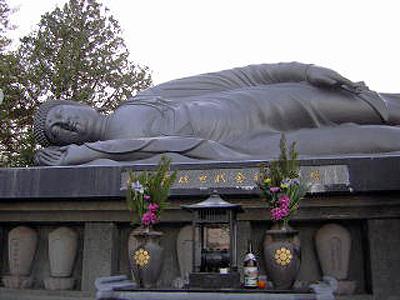|
Koutou Temple, where this statue of the reclining Buddha reposes, was built for the Arima clan in 1558 (Eiroku). However, the temple was moved to Shimabara when Shimabara Castle was constructed, and became the temple of the Matsukura Family.
The present temple was rebuilt in 1790 (Kansei 2), and there is a painting of the reclining Buddha, which was dedicated as a celebration of the reconstruction. Today's statue of the reclining Buddha was made in 1957 (Showa 32), after the painting's dedication.
The reclining Buddha is 8.6m long from head to toe, and 2.12m high. 'Nehan' is the Japanese word for Nirvana and refers to a spiritual state where the fire of worldly desire has disappeared and wisdom has been accomplished. It is also used as an expression for the dying Buddha (Buddha entering into parnirvana), which is known as the 'reclining Buddha'.
The statue of the reclining Buddha portrays Buddha preaching to his pupils on his deathbed under the paired sal trees of Kusinara, which was near his hometown.
The present temple was rebuilt in 1790 (Kansei 2), and there is a painting of the reclining Buddha, which was dedicated as a celebration of the reconstruction. Today's statue of the reclining Buddha was made in 1957 (Showa 32), after the painting's dedication.
The reclining Buddha is 8.6m long from head to toe, and 2.12m high. 'Nehan' is the Japanese word for Nirvana and refers to a spiritual state where the fire of worldly desire has disappeared and wisdom has been accomplished. It is also used as an expression for the dying Buddha (Buddha entering into parnirvana), which is known as the 'reclining Buddha'.
The statue of the reclining Buddha portrays Buddha preaching to his pupils on his deathbed under the paired sal trees of Kusinara, which was near his hometown.
| [+ADDRESS] | 
|











